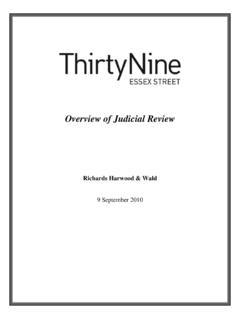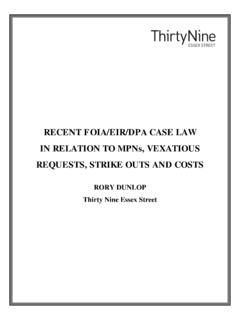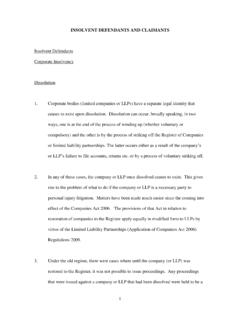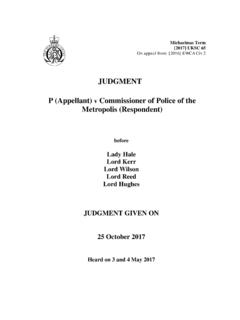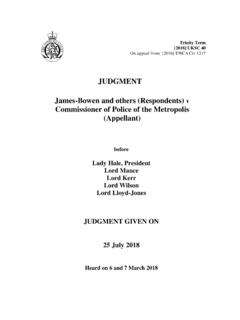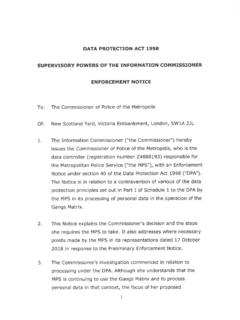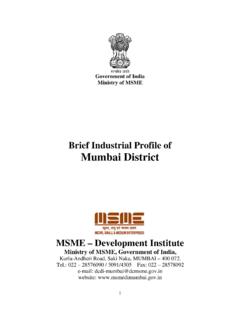Transcription of A BRIEF GUIDE TO CARRYING OUT BEST INTERESTS …
1 A BRIEF GUIDE TO CARRYING OUT. BEST INTERESTS ASSESSMENTS. November 2017. Editors A: Introduction Alex Ruck Keene 1. This purpose of this document is to provide for social Victoria Butler-Cole workers and those working in front-line clinical settings a Neil Allen BRIEF overview of the law and principles relating to the Annabel Lee Nicola Kohn assessment of best INTERESTS . Its focus is on: (a) how to Katie Scott apply the MCA 2005 principles when assessing best Simon Edwards INTERESTS ; and (b) how to record your assessment, primarily in the context of health and welfare It is a companion to our BRIEF GUIDE to CARRYING out capacity Disclaimer: This document is based upon the law as it stands as at 2. This document cannot take the place of legal advice. In any November 2017; it is case of doubt as to the principles or procedures to apply, it intended as a GUIDE to is always necessary to consult your legal department.
2 Nor good practice, and is not a does it take the place of the MCA Code of Practice, to which substitute for legal advice professionals must have regard; it does, however, upon the facts of any summarise case-law that has been determined since that specific case. No liability Code of Practice was written which has made clear how the is accepted for any MCA 2005 is to be applied. adverse consequences of B: Key principles reliance upon it. 3. 3. The core principles of the MCA 2005 are set out in The picture at the top, Colourful, is by Geoffrey _____. 1. Useful guidance in relation to the questions that arise in the context of Files, a young man with the management of property and affairs (called Making Financial Decisions autism. We are very - Guidance for assessing, supporting and empowering specific decision- grateful to him and his making) can be downloaded for free at family for permission to 2. See Section G.
3 Use his artwork. For all our mental capacity resources, click here A BRIEF GUIDE TO CARRYING OUT BEST INTERESTS ASSESSMENTS November 2017. Page 2. The core principles are: (2): a person (P) must be assumed to have capacity unless it is established that he lacks capacity (Strictly, of course, P is not P' unless they are the subject of proceedings before the Court of Protection who is alleged to lack capacity to take one or more decisions (Court of Protection Rules 2007, r7), but it is a convenient shorthand);. (3): P is not to be treated as unable to make a decision unless all practicable steps to help him to do so have been taken without success. (4): a person is not to be treated as unable to make a decision merely because he makes an unwise decision. (5): an act done, or decision made, under the MCA for or on behalf of a person who lacks capacity must be done, or made, in his best INTERESTS . (6): before the act is done, or the decision is made, regard must be had to whether the purpose for which it is needed can be as effectively achieved in a way that is less restrictive of the person's rights and freedom of action.
4 4. We set out the principles relating to capacity because it cannot be emphasised enough that all practicable steps must be taken to support a person to take their own decisions before any question of best INTERESTS assessment arise. In other words, the better the application of the MCA, the fewer best INTERESTS decisions will be required. C: Best INTERESTS assessment as a process 5. Best INTERESTS ' is deliberately not defined in the MCA 2005. However, sets out a series of matters that must be considered whenever a person is determining what is P's best INTERESTS . It is extremely important to understand that the MCA does not specify what is in the person's best INTERESTS it sets down the process to apply. In other words, it is possible for two individuals conscientiously to apply the checklist' and to come to different views as to where P's best INTERESTS lie; so long as both views were reasonable, both could act upon their beliefs to carry out routine acts of care and treatment safe in the knowledge that they were protected from liability under MCA 6.
5 Assessing best INTERESTS is therefore a process. It is a process that recognises that a conclusion 3. So long as, if those acts amounted to restraint, they also satisfied the additional requirements that are imposed by MCA 2005 that the act is necessary and proportionate to the likelihood of P suffering harm and the seriousness of that harm. For all our mental capacity resources, click here A BRIEF GUIDE TO CARRYING OUT BEST INTERESTS ASSESSMENTS November 2017. Page 3. that a person lacks decision-making capacity is not an off-switch for their rights and It might perhaps best be considered as a process of constructing a decision on behalf of the person who cannot make that decision As the Supreme Court emphasised in Aintree University NHS Hospitals Trust v James 6 (a medical treatment case) [t]he purpose of the best INTERESTS test is to consider matters from the patient's point of view. 7 It is critically important to understand that the purpose of the process is to arrive at the decision that health and social professionals reasonably believe is the right decision for the person themselves, as an individual human being8 not the decision that best fits with the outcome that the professionals desire.
6 7. In practice, the process of assessing best INTERESTS can be made more difficult by confusion (1) as to whose task it is to determine where a person's best INTERESTS lie; and (2) between best INTERESTS decision-making on behalf of that person and decision-making by public bodies as to the health or social care services to deliver to that person. We address both of these matters in Section F. 8. There are two last important points to emphasise here: (1) Because best INTERESTS assessment is a process, what is required is an understanding of how to apply that process to the facts of any given case, and how to document the application of that process. It is only that way that health and social professionals can reach decisions that can properly be defended in the event of any subsequent challenge;. (2) What will be required in any given case will depend upon the urgency and gravity of the situation. As the Court of Appeal has emphasised, the defence afforded to health and social care professionals delivering routine acts of care and treatment9 is pervaded by the concepts of reasonableness, practicability and appropriateness.
7 10 What will be required to have a reasonable belief as to a person's best INTERESTS in the context of an A&E department at 3:00. am will be very different to what may be required in the context of a decision whether an elderly person with dementia should move from their home of 60 years into a care home. 4. Wye Valley NHS Trust v Mr B [2015] EWCOP 60 at paragraph 11. Hyperlinks in this Guidance Note are to the case comments in the database maintained by the editors of the 39 Essex Chambers Mental Capacity Law Report. For further useful resources, see Section G below. 5. The concept of constructing decisions' is one that we have adopted, with gratitude, from the pioneering work of Adrian Ward, chair of the Mental Health and Disability Committee of the Law Society of Scotland. See, in particular, Chapter 13 of Adrian's Adult Incapacity (2003, W Green). 6. [2014] UKSC 67. 7. At paragraph 45. 8. Aintree at paragraph 45.
8 9. Under MCA 2005 (in some cases read together with ). 10. Commissioner of Police for the Metropolis v ZH [2013] EWCA Civ 69 at paragraph 40. For all our mental capacity resources, click here A BRIEF GUIDE TO CARRYING OUT BEST INTERESTS ASSESSMENTS November 2017. Page 4. D: The checklist 9. Section 4 MCA contains a checklist of factors which can be summarised as Not all the factors in the best INTERESTS checklist' will be relevant to all types of decisions or actions, but they must still be considered if only to be disregarded as irrelevant to that particular situation. Equal consideration and non-discrimination 10. The person determining best INTERESTS must not make assumptions about someone's best INTERESTS merely on the basis of their age or appearance, condition or an aspect of their behaviour. All relevant circumstances 11. Try to identify all the issues and circumstances relating to the decision in question which are most relevant to the person who lacks capacity to make that decision.
9 Regaining capacity 12. Consider whether the person is likely to regain capacity ( after receiving medical treatment). If so, can the decision wait until then? Permitting and encouraging participation 13. Do whatever is reasonably practicable to permit and encourage the person to participate, or to improve their ability to participate, as fully as possible in any act done or any decision affecting them. The person's wishes, feelings, beliefs and values 14. Try to find out the views of the person lacking capacity, including: The person's past and present wishes and feelings both current views and whether any relevant views have been expressed in the past, either verbally, in writing or through behaviour or habits. Any beliefs and values ( religious, cultural, moral or political) that would be likely to influence the decision in question. Any other factors the person would be likely to consider if able to do so (this could include the impact of the decision on others12).
10 11. This section draws on chapter 3 of the 4th edition of the Law Society/British Medical Association Assessment of Mental Capacity (2015), edited by Alex. 12. A good example of this is David Ross v A [2015] EWCOP 46, where Senior Judge Lush authorised the payment of P's brother's school fees from P's clinical negligence award in circumstances where it was clear that P's wellbeing depended in large part upon the wellbeing of her family as a whole. For all our mental capacity resources, click here A BRIEF GUIDE TO CARRYING OUT BEST INTERESTS ASSESSMENTS November 2017. Page 5. 15. It is extremely important in this process to take all practicable steps to assist the person concerned in expressing their wishes and feelings (and to document those steps). 16. It may not always be possible to identify reliable wishes and feelings. It may also be the case that a person's past wishes and feelings may be radically different to those that they are now demonstrate.
